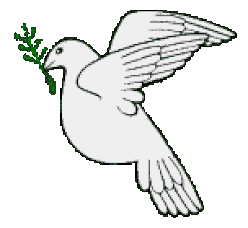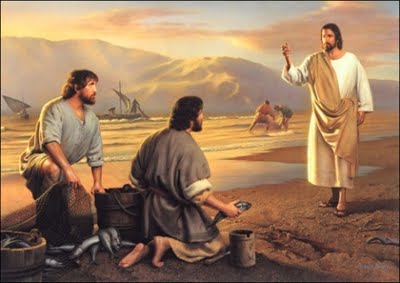Mark 1:14-28
Lesson 64
Lesson 64
Read both the "King James Bible" and the "New Living Translation."
In this lesson:
About a year has passed since Jesus was tempted in the wilderness (lesson 63).
Jesus chooses the first four disciples.
The first preaching.
The first healing.
The Messiah's fame spreads.
About a year has passed since Jesus was tempted in the wilderness (lesson 63).
Jesus chooses the first four disciples.
The first preaching.
The first healing.
The Messiah's fame spreads.
Simon, Peter, and Andrew are called by Jesus.
Study Tip:
When you come across a critical verse write it down, memorize it, and ponder its meaning.
When you come across a critical verse write it down, memorize it, and ponder its meaning.
Who was -
Simon -
Jesus' apostle Simon Peter (2 Peter 1:1), also called Peter, Simeon (Acts 15:14), Simon Bar-jona (Matthew 16:17) or just Simon (Matthew 10:2). The Greek translation for Peter is Petros (meaning rock), the Aramaic is Cephas (John 1:42), and the Latin is Petrus. Peter was born in Bethsaida (John 1:44) on the northern coast of the Sea of Galilee. His father was Jona, also called Jonah or Jonas, (John 1:42; 21:15-17) and his younger brother was the disciple Andrew (John 1:40). Peter was a simple fisherman in Capernaum (Matthew 4:18; Mark 1:16) and partners with James and John (Luke 5:10) when he met Jesus. Bold but uneducated (Acts 4:13), Peter (along with Andrew) became the first disciples (Matthew 4:18-20; Mark 1:16-18) and part of Jesus' inner circle. Whenever Jesus was in Galilee, He used Peter's home as His base. Peter wrote the First and Second Epistles of Peter (1 Peter 1:1; 2 Peter 1:1), walked on water (Matthew 14:28-31), performed the miracle at the Beautiful Gate (Acts 3:1-10), witnessed the Transfiguration of Jesus (Matthew 17:1-9; Mark 9:1-13; Luke 9:28-36; 2 Peter 1:16-18), the resurrection of Jairus' daughter (Mark 5:37-42), and Jesus praying in Gethsemane as He waited to be arrested (Mark 14:32-34). Peter rose up before the mob to resist Jesus' arrest (John 18:10-13) yet within hours denied even knowing Him three times (Matthew 26:69-75). After the crucifixion, Peter became the rock on which Jesus built His church (Matthew 16:16-19) and helped spread the Gospel from Jerusalem to Rome. Whenever the Bible lists the twelve disciples/apostles, Peter is always listed first (Matthew 10:2-4; Mark 3:16-19) and Roman Catholics call him their first Pope. Peter was married (Matthew 8:14; Mark 1:30; Luke 4:38) and brought his wife on his missionary journeys (1 Corinthians 9:5). Although Jesus told Peter he would be crucified when he "shalt be old" (John 21:18-19), the Bible gives no details of his death. However, the Christian writers Quintus Septimius Florens Tertullianus (AD 160-220) and Origen Adamantius (AD 185-254) report that Peter was crucified upside down by Emperor Nero in Rome about AD 70.
Andrew -
A follower of John the Baptist who became one of the original twelve disciples (John 1:40). From Bethsaida, Andrew was the son of Jonas and a fisherman with his older brother Simon Peter when they were called by Jesus to become the first disciples. It is said that Andrew was crucified in Achaia for refusing to worship pagan gods.
James -
One of the original twelve disciples. James was the son of Zebedee (Matthew 4:21; Mark 1:19) and Salome (Mary's sister), Jesus' cousin, and older brother of the disciple John. Born into a wealthy family, James was a fisherman and partner with Peter (Luke 5:10) when Jesus called and made him part of His inner circle (along with Peter and John). He was allowed to witness the Transfiguration (Matthew 17:1-9; Mark 9:1-13; Luke 9:28-36), the resurrection of Jairus' daughter (Mark 5:37-42; Luke 8:49-55), and Jesus praying in Gethsemane while He waited to be arrested (Matthew 26:37; Mark 14:32-34). Jesus nicknamed James and John the "Sons of Thunder" (Mark 3:17). Jesus predicted that James would meet a bloody end (Matthew 20:23; Mark 10:38-39) and sure enough James was the first of the twelve apostles to die (not counting Judas), as documented in Acts 12:1-2.
Zebedee -
The father of James and John (who Jesus nicknamed "The sons of thunder"). Married to Mary's sister Salome, Zebedee was Jesus' uncle and a Galilean fisherman from Capernaum. Since he owned two boats and had "hired servants" (Mark 1:20), we know he was a man of some means.
John -
One of the original twelve disciples, John was the son of Zebedee (Matthew 4:21-22; 10:2; Mark 1:19-20; 10:35; Luke 5:10-11) and Salome, the younger brother to the disciple James (Matthew 10:2), and a fisherman when called by Jesus. John's mother Salome and the Virgin Mary were sisters, making Jesus and John cousins. John was born in Palestine (Bethsaida) into a wealthy family, was well connected, knew the high priest (John 18:15), captained a fishing boat on the Sea of Galilee and gave up everything to follow the Messiah. As indicated above, Jesus nicknamed John and his brother James the "Sons of Thunder" (Mark 3:17) and John 13:23; 19:26; 20:2; 21:7; and 21:20 refer to him as "the disciple whom Jesus loved," quite an honor. Along with Peter and James, John was part of Jesus' inner circle and was allowed to witness the resurrection of Jairus' daughter (Mark 5:37-42), Jesus praying in Gethsemane while waiting to be arrested (Mark 14:32-34), and the Transfiguration (Mark 9:1-13; Luke 9:28-36). Unlike the other disciples who ran and hid when Jesus was arrested, John followed Christ to Calvary, witnessed the crucifixion, and stayed by Jesus' side until the end. While dying on the cross, Jesus turned over His mothers care to John (John 19:26-27). After the crucifixion, John became a driving force for Christianity. Bold yet uneducated (Acts 4:13), John wrote "The Gospel According to St. John," the Three Epistles of John, and the prophetic "The Revelation of John the Divine." Late in his life, the Romans exiled John to the island of Patmos, a penal colony in the Aegean Sea fifty miles offshore from Ephesus (in modern-day Turkey), for preaching the word of God (Revelation 1:9). He was eventually freed and died an old man around AD 98 in Ephesus. John was the last of the original twelve disciples to die and the only one to die a natural death.
Simon -
Jesus' apostle Simon Peter (2 Peter 1:1), also called Peter, Simeon (Acts 15:14), Simon Bar-jona (Matthew 16:17) or just Simon (Matthew 10:2). The Greek translation for Peter is Petros (meaning rock), the Aramaic is Cephas (John 1:42), and the Latin is Petrus. Peter was born in Bethsaida (John 1:44) on the northern coast of the Sea of Galilee. His father was Jona, also called Jonah or Jonas, (John 1:42; 21:15-17) and his younger brother was the disciple Andrew (John 1:40). Peter was a simple fisherman in Capernaum (Matthew 4:18; Mark 1:16) and partners with James and John (Luke 5:10) when he met Jesus. Bold but uneducated (Acts 4:13), Peter (along with Andrew) became the first disciples (Matthew 4:18-20; Mark 1:16-18) and part of Jesus' inner circle. Whenever Jesus was in Galilee, He used Peter's home as His base. Peter wrote the First and Second Epistles of Peter (1 Peter 1:1; 2 Peter 1:1), walked on water (Matthew 14:28-31), performed the miracle at the Beautiful Gate (Acts 3:1-10), witnessed the Transfiguration of Jesus (Matthew 17:1-9; Mark 9:1-13; Luke 9:28-36; 2 Peter 1:16-18), the resurrection of Jairus' daughter (Mark 5:37-42), and Jesus praying in Gethsemane as He waited to be arrested (Mark 14:32-34). Peter rose up before the mob to resist Jesus' arrest (John 18:10-13) yet within hours denied even knowing Him three times (Matthew 26:69-75). After the crucifixion, Peter became the rock on which Jesus built His church (Matthew 16:16-19) and helped spread the Gospel from Jerusalem to Rome. Whenever the Bible lists the twelve disciples/apostles, Peter is always listed first (Matthew 10:2-4; Mark 3:16-19) and Roman Catholics call him their first Pope. Peter was married (Matthew 8:14; Mark 1:30; Luke 4:38) and brought his wife on his missionary journeys (1 Corinthians 9:5). Although Jesus told Peter he would be crucified when he "shalt be old" (John 21:18-19), the Bible gives no details of his death. However, the Christian writers Quintus Septimius Florens Tertullianus (AD 160-220) and Origen Adamantius (AD 185-254) report that Peter was crucified upside down by Emperor Nero in Rome about AD 70.
Andrew -
A follower of John the Baptist who became one of the original twelve disciples (John 1:40). From Bethsaida, Andrew was the son of Jonas and a fisherman with his older brother Simon Peter when they were called by Jesus to become the first disciples. It is said that Andrew was crucified in Achaia for refusing to worship pagan gods.
James -
One of the original twelve disciples. James was the son of Zebedee (Matthew 4:21; Mark 1:19) and Salome (Mary's sister), Jesus' cousin, and older brother of the disciple John. Born into a wealthy family, James was a fisherman and partner with Peter (Luke 5:10) when Jesus called and made him part of His inner circle (along with Peter and John). He was allowed to witness the Transfiguration (Matthew 17:1-9; Mark 9:1-13; Luke 9:28-36), the resurrection of Jairus' daughter (Mark 5:37-42; Luke 8:49-55), and Jesus praying in Gethsemane while He waited to be arrested (Matthew 26:37; Mark 14:32-34). Jesus nicknamed James and John the "Sons of Thunder" (Mark 3:17). Jesus predicted that James would meet a bloody end (Matthew 20:23; Mark 10:38-39) and sure enough James was the first of the twelve apostles to die (not counting Judas), as documented in Acts 12:1-2.
Zebedee -
The father of James and John (who Jesus nicknamed "The sons of thunder"). Married to Mary's sister Salome, Zebedee was Jesus' uncle and a Galilean fisherman from Capernaum. Since he owned two boats and had "hired servants" (Mark 1:20), we know he was a man of some means.
John -
One of the original twelve disciples, John was the son of Zebedee (Matthew 4:21-22; 10:2; Mark 1:19-20; 10:35; Luke 5:10-11) and Salome, the younger brother to the disciple James (Matthew 10:2), and a fisherman when called by Jesus. John's mother Salome and the Virgin Mary were sisters, making Jesus and John cousins. John was born in Palestine (Bethsaida) into a wealthy family, was well connected, knew the high priest (John 18:15), captained a fishing boat on the Sea of Galilee and gave up everything to follow the Messiah. As indicated above, Jesus nicknamed John and his brother James the "Sons of Thunder" (Mark 3:17) and John 13:23; 19:26; 20:2; 21:7; and 21:20 refer to him as "the disciple whom Jesus loved," quite an honor. Along with Peter and James, John was part of Jesus' inner circle and was allowed to witness the resurrection of Jairus' daughter (Mark 5:37-42), Jesus praying in Gethsemane while waiting to be arrested (Mark 14:32-34), and the Transfiguration (Mark 9:1-13; Luke 9:28-36). Unlike the other disciples who ran and hid when Jesus was arrested, John followed Christ to Calvary, witnessed the crucifixion, and stayed by Jesus' side until the end. While dying on the cross, Jesus turned over His mothers care to John (John 19:26-27). After the crucifixion, John became a driving force for Christianity. Bold yet uneducated (Acts 4:13), John wrote "The Gospel According to St. John," the Three Epistles of John, and the prophetic "The Revelation of John the Divine." Late in his life, the Romans exiled John to the island of Patmos, a penal colony in the Aegean Sea fifty miles offshore from Ephesus (in modern-day Turkey), for preaching the word of God (Revelation 1:9). He was eventually freed and died an old man around AD 98 in Ephesus. John was the last of the original twelve disciples to die and the only one to die a natural death.




